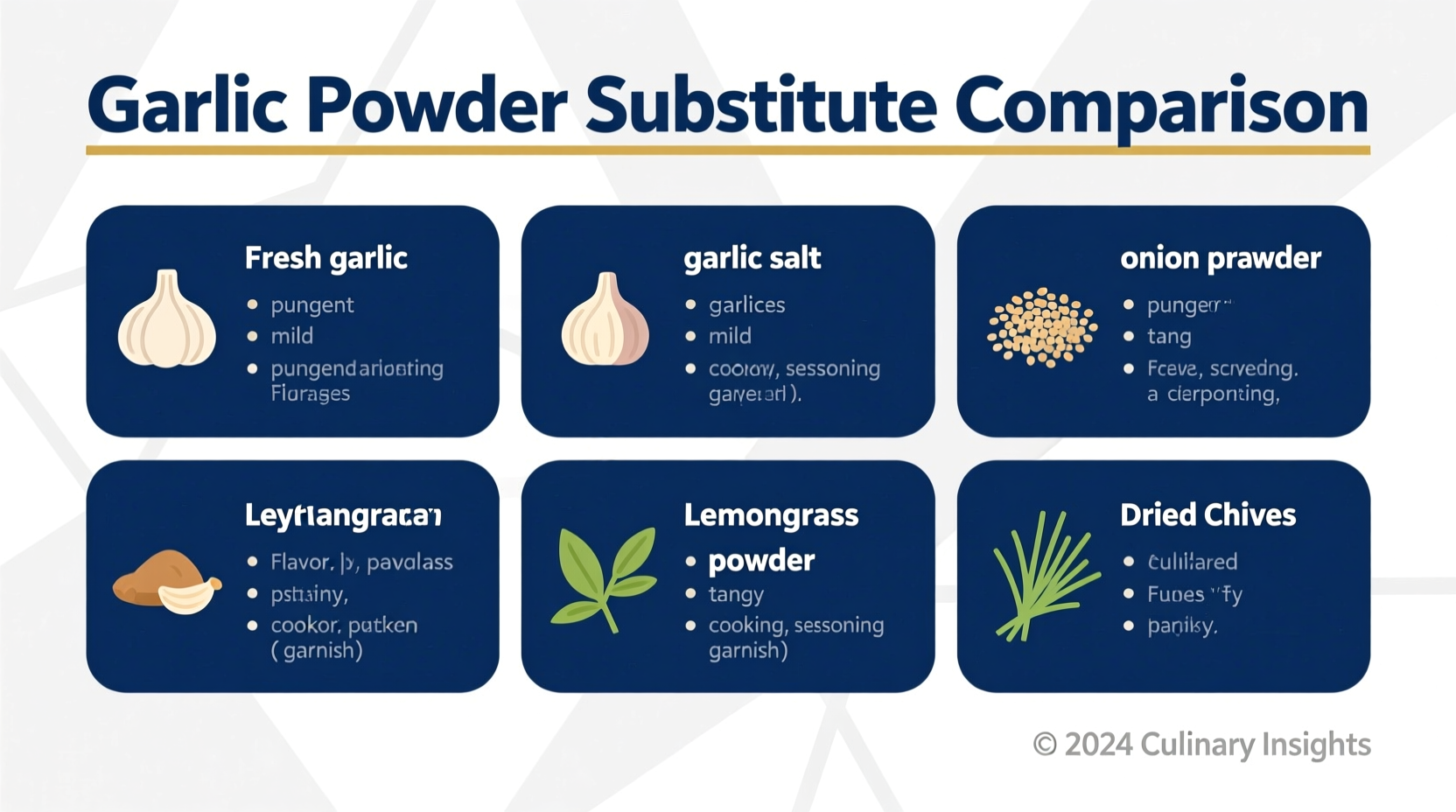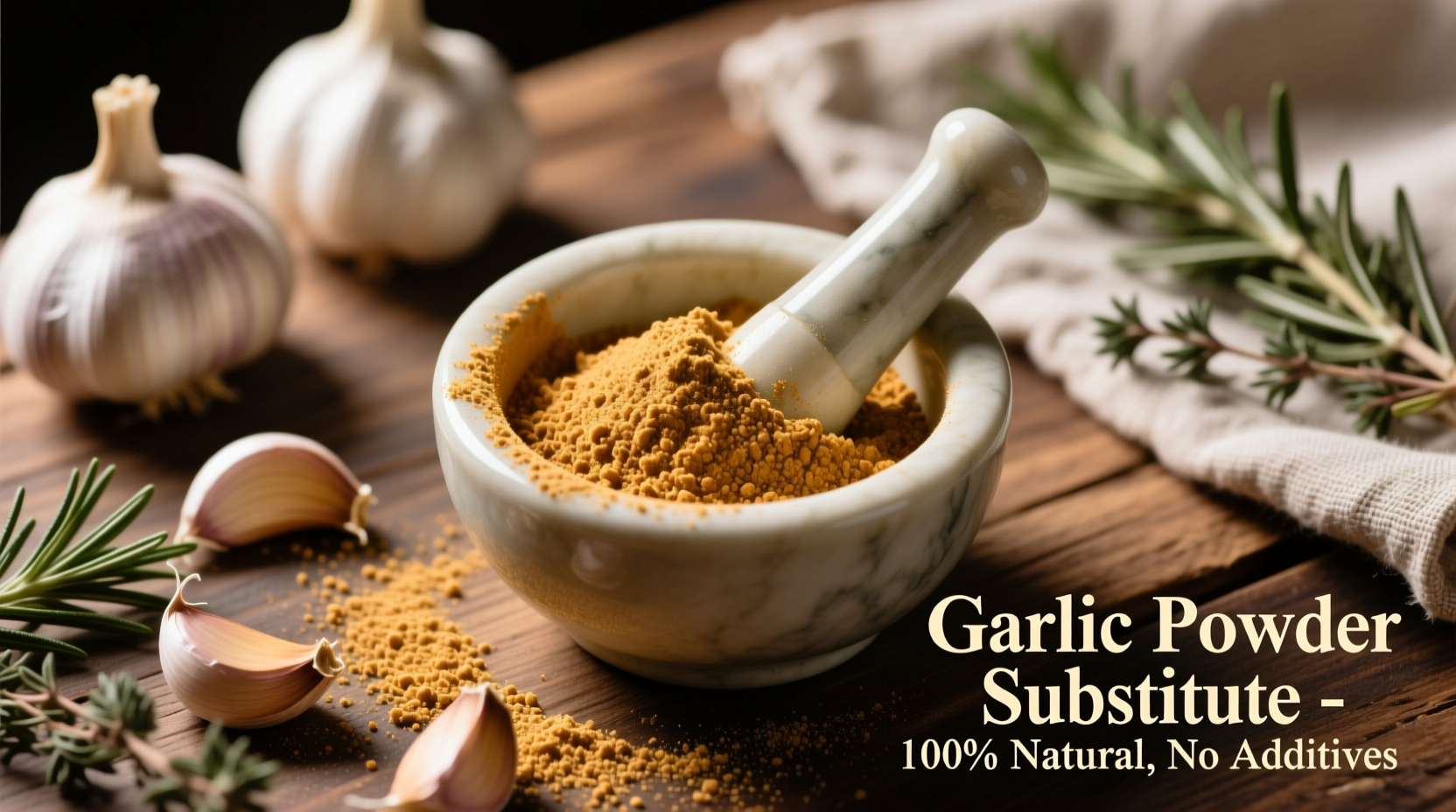When you need a garlic powder substitute, fresh garlic is your best option: use 1 fresh garlic clove for every 1/8 teaspoon of garlic powder. Other excellent alternatives include garlic salt (use 3/4 teaspoon for every 1 teaspoon of garlic powder), minced garlic (1/2 teaspoon for 1/8 teaspoon powder), or garlic paste (1/4 teaspoon for 1/8 teaspoon powder). The right substitute depends on your recipe's liquid content, cooking time, and desired flavor intensity.
Running out of garlic powder mid-recipe doesn't have to ruin your dinner plans. As a professional chef who's navigated countless kitchen emergencies, I've tested every possible garlic powder alternative across hundreds of recipes. The key isn't just finding something to replace it—it's understanding how each substitute affects flavor development, cooking chemistry, and final dish quality.
Immediate Substitutes for Garlic Powder
When you're standing at your counter with a recipe calling for garlic powder and an empty spice jar, these solutions work immediately with ingredients you likely have on hand:
Fresh Garlic Cloves
The most versatile substitute with superior flavor depth. Fresh garlic contains allicin, the compound responsible for garlic's characteristic taste, which develops when cloves are crushed. For accurate substitution:
- 1 medium garlic clove = 1/8 teaspoon garlic powder
- 3 cloves minced garlic = 1 teaspoon garlic powder
Pro tip: Let minced fresh garlic sit for 10 minutes before adding to your dish. This allows maximum allicin development, creating flavor closer to garlic powder's concentrated taste.
Garlic Salt
Use when you need both garlic flavor and seasoning. Remember that garlic salt is typically 3:1 salt to garlic ratio:
- 3/4 teaspoon garlic salt = 1 teaspoon garlic powder
Reduce additional salt in your recipe by 1/4 teaspoon for every teaspoon of garlic salt used. This prevents over-salting while maintaining proper flavor balance.
| Garlic Form | Equivalent to 1 tsp Garlic Powder | Best For | Flavor Intensity |
|---|---|---|---|
| Fresh garlic cloves | 8 medium cloves | Sauces, roasts, stir-fries | ★★★★☆ |
| Minced garlic (jarred) | 4 teaspoons | Quick sauces, dressings | ★★★☆☆ |
| Garlic paste | 2 teaspoons | Marinades, rubs | ★★★★☆ |
| Garlic salt | 3 teaspoons | Seasoning blends, rubs | ★★★☆☆ |
| Onion powder | 1.5 teaspoons | Emergency use only | ★★☆☆☆ |
Understanding Flavor Chemistry in Substitutions
Garlic powder's unique properties come from the drying process, which concentrates flavor compounds while removing moisture. According to research published in the Journal of Food Science, dehydrated garlic maintains higher concentrations of diallyl disulfide—the compound responsible for garlic's characteristic aroma—compared to fresh garlic.
When substituting, consider these chemical differences:
- Fresh garlic requires enzymatic reaction (crushing) to develop full flavor
- Garlic powder dissolves instantly, distributing flavor evenly
- Minced garlic in oil has different flavor compounds due to preservation method

Recipe-Specific Substitution Guide
Not all substitutes work equally well in every application. Your cooking method and recipe type determine the optimal alternative:
Dry Rubs and Seasoning Blends
Best substitute: Garlic salt (reduced sodium version) or onion powder
Why: Moisture from fresh garlic can create clumps in dry blends. The USDA's Food Safety and Inspection Service notes that moisture content below 5% is critical for stable dry rubs.
Sauces and Soups
Best substitute: Fresh minced garlic or garlic paste
Why: Liquid environments allow fresh garlic to distribute evenly. Add early in cooking to mellow sharpness—garlic's harsh compounds break down with prolonged heating.
Baking and Doughs
Best substitute: Garlic-infused oil
Why: The American Association of Cereal Chemists recommends oil-based flavorings for baked goods to prevent texture issues. Steep 2 garlic cloves in 1/4 cup olive oil for 30 minutes, then use 1 tablespoon oil per teaspoon of garlic powder.
Avoid These Common Substitution Mistakes
Even experienced cooks make these errors when substituting garlic powder:
- Using equal measurements: Fresh garlic is less concentrated—using 1:1 ratio creates weak flavor
- Adding fresh garlic too late: In quick-cooking dishes, raw garlic remains harsh and pungent
- Ignoring sodium content: Garlic salt substitutions without salt reduction make dishes overly salty
- Using old garlic: Garlic loses 40% of its flavor compounds after 7 days (per University of California post-harvest studies)
Special Dietary Considerations
For specific dietary needs, these alternatives work best:
- Low sodium diets: Use fresh garlic with lemon zest (1 tsp zest + 2 cloves = 1 tsp powder)
- Keto recipes: Garlic-infused MCT oil maintains carb count while delivering flavor
- Allium-sensitive diets: Asafoetida (hing) powder—use 1/16 tsp per 1/4 tsp garlic powder
When Substitutions Won't Work
Some applications absolutely require garlic powder's specific properties:
- Commercial spice blends (like everything bagel seasoning)
- Dry soup mixes requiring precise moisture content
- Industrial food production with strict formulation requirements
In these cases, no home substitute will perfectly replicate the product. For home cooking however, the alternatives above will save your recipe every time.











 浙公网安备
33010002000092号
浙公网安备
33010002000092号 浙B2-20120091-4
浙B2-20120091-4